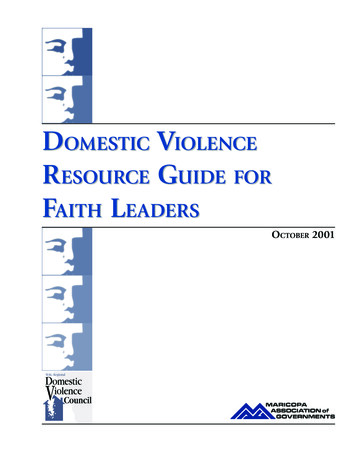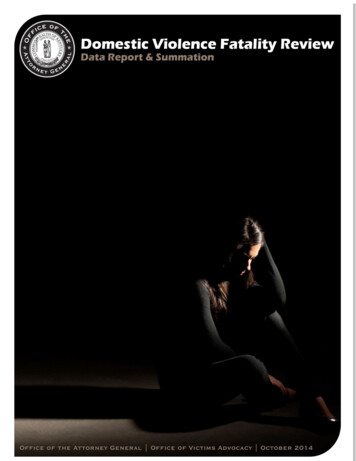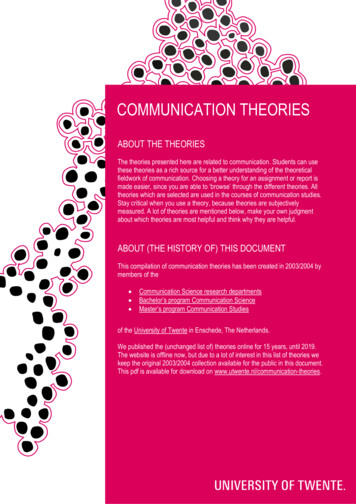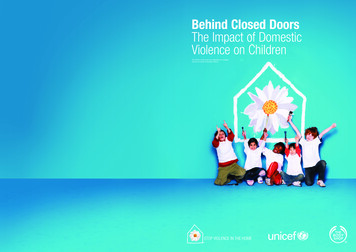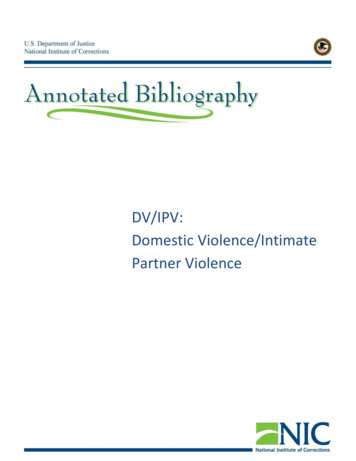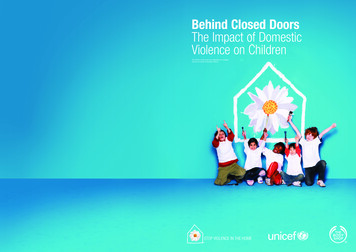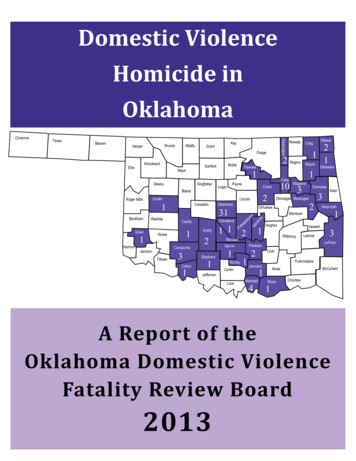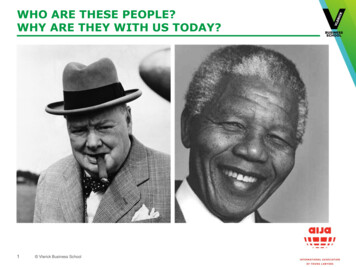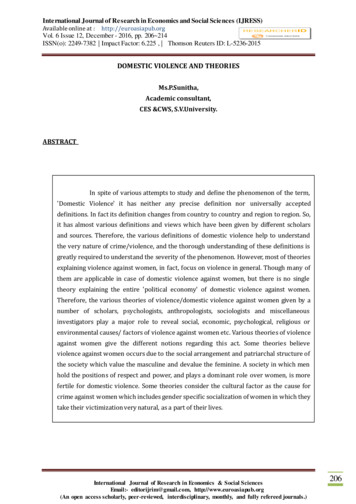
Transcription
International Journal of Research in Economics and Social Sciences (IJRESS)Available online at :http://euroasiapub.orgVol. 6 Issue 12, December - 2016, pp. 206 214ISSN(o): 2249-7382 Impact Factor: 6.225 , Thomson Reuters ID: L-5236-2015DOMESTIC VIOLENCE AND THEORIESMs.P.Sunitha,Academic consultant,CES &CWS, S.V.University.ABSTRACTIn spite of various attempts to study and define the phenomenon of the term,'Domestic Violence' it has neither any precise definition nor universally accepteddefinitions. In fact its definition changes from country to country and region to region. So,it has almost various definitions and views which have been given by different scholarsand sources. Therefore, the various definitions of domestic violence help to understandthe very nature of crime/violence, and the thorough understanding of these definitions isgreatly required to understand the severity of the phenomenon. However, most of theoriesexplaining violence against women, in fact, focus on violence in general. Though many ofthem are applicable in case of domestic violence against women, but there is no singletheory explaining the entire 'political economy' of domestic violence against women.Therefore, the various theories of violence/domestic violence against women given by anumber of scholars, psychologists, anthropologists, sociologists and miscellaneousinvestigators play a major role to reveal social, economic, psychological, religious orenvironmental causes/ factors of violence against women etc. Various theories of violenceagainst women give the different notions regarding this act. Some theories believeviolence against women occurs due to the social arrangement and patriarchal structure ofthe society which value the masculine and devalue the feminine. A society in which menhold the positions of respect and power, and plays a dominant role over women, is morefertile for domestic violence. Some theories consider the cultural factor as the cause forcrime against women which includes gender specific socialization of women in which theytake their victimization very natural, as a part of their lives.International Journal of Research in Economics & Social SciencesEmail:- editorijrim@gmail.com, http://www.euroasiapub.org(An open access scholarly, peer-reviewed, interdisciplinary, monthly, and fully refereed journals.)206
International Journal of Research in Economics and Social Sciences (IJRESS)Vol. 6 Issue 12, December - 2016ISSN(o): 2249-7382 Impact Factor: 6.225INTRODUCTIONTherefore to explain the concept of violence, different definitions of violence havebeen given at different sources. To sum up, the definitions of domestic violence have undergonelots of changes both in terms of acts/forms of domestic violence to actors/perpetrators ofdomestic violence. The broadened definition of domestic violence, its nature and impactcompelled the global community to acknowledge it as a crime, something that destroys thedignity and violates the rights of women who are worst and most common target of domesticviolence. Though domestic violence is still not accepted as a crime, both by the victim as well asperpetrator, Infact it adversely effects the gender equation and negatively affects the wellbeing offamily, society and the economy. The acknowledgement of domestic violence has destroyed manymyths like man is not a protector rather a perpetrator/destroyer of the rights, dignity andwellbeing of women; regarding 'home' as 'poor mans' castle' is no more absolutely correct as it isequally a site of gender based opposition, exploitation and dis crimination. Lastly domesticviolence is a product of human cruelty and the urge to maintain male dominance and chauvinismand not a natural, religious or cultural practice since time immemorial.Thus domestic violence according to various theories means the following: Domestic violence is a kind of male coercion largely a product of patriarchy. It persists ina society governed and dominated by males that values male power due to its controlover economic resources. The patriarchal structure of family creates and sustains the domestic violence. Domestic violence is a behavioral problem as a result of male hormones liketestosterone. Violence often has roots in psychological reasons. Stressful situations in family and society lead to frustrations that manifest itself in formof violence. People with low esteem in most of the cases take recourse to violence in order. Domestic violence against women is most of the time a cultural practice. The economic and physical weakness make women helpless and vulnerable to violence. Many time stress and tension creates frustration resulting in aggressive behaviourparticular in intra-family relations.Similarly cultural definition of appropriate sex roles,expectation of roles within relationships, belief in inherent superiority of males, values that givemen priorities, notion of family as a private sphere under the total control of men are alsoconsidered major factors for women's victimization. Other theories focus more on pooreconomic condition of offenders, which compels them to commit crime against women. Itincludes persons living in absolute poverty, lack of job opportunities, unfavorable frustratingInternational Journal of Research in Economics & Social SciencesEmail:- editorijrim@gmail.com, http://www.euroasiapub.org(An open access scholarly, peer-reviewed, interdisciplinary, monthly, and fully refereed journal)207
International Journal of Research in Economics and Social Sciences (IJRESS)Vol. 6 Issue 12, December - 2016ISSN(o): 2249-7382 Impact Factor: 6.225working condition. And bad housing. Similarly members of slum areas living a disorganizedfamily life in absolute poverty can also be the potential victimizer. Thus women become the softtarget of alienated and frustrated individual.Feminist Theory: The social problem approachThis approach emerged during the decade of 1970s when women's movement was on its heights.The theory looks upon 'violence' as male coercion of women. The forms of violence may varyfrom each other like various forms of violence are rape, sexual assault, female infanticide, maritalrape, and female circumcision etc. This theory believes that domestic violence prevails due tounequal power relations of men and women in the society and the family. ' Feminist theoristsnever use the term such as 'family violence' 'spousal abuse' 'marital violence' and 'conjugalviolence' rather they advocate terms such as 'wife beating' 'domestic violence' 'battered women'and 'women abuse' to depict the phenomenon ofdomestic violence. The theory is critical ofpatriarchal structure that facilitates and supports male dominance in society, violence is a meansto maintain male hegemony in the family. The consequent social structure, based on patriarchalvalues, male power and status, and devalues of the feminine, ultimately lead to the victimizationof women. Also women's economic dependence is identified as the major cause of subordinationas well as violence against them.The Family System Theory:This theory emerged during the decade of 1960s to 1980s when more and more scholars andresearchers began to understand and analyse domestic violence from a sociological perspectivewhich maintains that domestic violence or spousal abuse is one form of family violence. Otherforms of domestic violence include child abuse, sibling abuse and parent abuse. This theoreticalperspective asserts that the cause of spouse abuse lies in the structure of the contemporaryfamily institution which is a fertile ground for violence. Though family is a private place so ithides violence which is due to lack of control on behaviour. ''Physiological Theory:This theory focuses on nature of evolution and the genetic reasons which are responsible forviolent male behaviour. It also emphasizes on brain structures, chemical imbalances, dietarydeficiencies, and hormonal factors such as testosterone, for violence committed by males.Genetic and hormonal factors explain the reasons for the greater pre-disposition towardsviolence in men than in women. There are also some identified theories which have samerelevance for understanding violence committed by an individual. These theories can beclassified on the basis of three theoretical level of analysis.International Journal of Research in Economics & Social SciencesEmail:- editorijrim@gmail.com, http://www.euroasiapub.org(An open access scholarly, peer-reviewed, interdisciplinary, monthly, and fully refereed journal)208
International Journal of Research in Economics and Social Sciences (IJRESS)Vol. 6 Issue 12, December - 2016ISSN(o): 2249-7382 Impact Factor: 6.225 Psychiatric or psycho-pathological analysis. Socio-psychological analysis and Sociological or socio-cultural analysisPsycho-Pathological Theory":The psycho-pathological model focuses on the personality characteristics of offenders andvictims as chief determinants of criminal violence. This model includes analysis that links mentalillness, alcohol and other intra individual phenomenon to acts of violence. So, according to thistheory causes of violence against women arise from the offender's psychological problem likedepression, impulsiveness, uncontrolled emotions. This theory also urges that violence againstwomen arises out of psychological problems of victims. This theory defines the characteristics ofPerpetrators as weak pathologically jealous men with low self-esteem and experiencinginsecurity about their masculinity.Socio-psychological theories:This model examines the types of everyday interactions, stressful situations or familyinteractional patterns which lead to violence. Whenever there is failure to achieve certain goal orend, frustrated perpetrator and his frustration turn into aggression. According to this theoryaggression is always directed towards the source of frustration.Frustration-Aggration Theory: This theory is stated by Dollard in 1939 to explain howfrustration is linked to aggression. Whenever there is failure to achieve certain goal or end,perpetrator is frustrated and frustration turns into aggression. According to this theoryaggression is always directed towards the source of frustration. 'Perversion Theory:According to Freud's early theory, 1949 perversion means essentially the persistence in the adultof infantile behaviour instead of adult behaviour. Infantile traits fail to undergo the normalprocess of integration during puberty but are not converted into neurotic symptoms. Violencecan be the product of strong inborn derives or of pathological experiences in infancy or earlychildhood,''Self-Attitude Theory:This theory maintains that in a society culture or group that value violence, persons of lowself-esteem performs the act of violence to maintain their images in the eyes of others andthemselves too.'International Journal of Research in Economics & Social SciencesEmail:- editorijrim@gmail.com, http://www.euroasiapub.org(An open access scholarly, peer-reviewed, interdisciplinary, monthly, and fully refereed journal)209
International Journal of Research in Economics and Social Sciences (IJRESS)Vol. 6 Issue 12, December - 2016ISSN(o): 2249-7382 Impact Factor: 6.225Motive Attribution Theory:This theory specifies the process used by actors to impute the motivations (dispositional state)of others. It explains how the structure of relations is such that there is a high probability of maleviolent intent being attributed to the actions of other individuals thereby setting in motion anescalating cycle of resentment and aggression.'The Cycle Theory of Violence and Psycho-social theory of LearnedHelplessness:Both of the theories are developed by Lenore Walker's. The cycle theory defines three distinctcycle or phase of violence like tension building stage, the acute battering incident andkindness/living behaviour. According to this theory in first stage when minor battering occur thewomen adapts, rationalizes and externalizes the problem. In second phase actual batteringphysically, emotionally and psychologically starts, whereas third phase includes love, affection,and promises by the husband never to repeat the incidents again. This phenomenon keeps onrepeating in all battered women. The psycho-socio theory of learned helplessness focuses on thefactors which reinforce battered women's victimizations. According to this theory the'helplessness' of battered women compels them to accept the exploitative situations.’Socio-cultural Theories:This model provides a macro level analysis of criminal violence. It also examines criminalviolence in terms of socially structured inequality and social and cultural attitudes and normsregarding anti-social behaviour and interpersonal relations.Structural Theory:This theory is developed to represent those social groups, which have typical levels of stress,deprivation and frustration and the sources of their disposal. According to this theory,individuals who have high stress with low resources would be more aggressive. The main causeof stress is being regarded as 'economic conditions', 'bad housing', 'poverty', lack of jobopportunities and unfavorable and frustrating work conditions.System Tension and Feedback System Theory:This theory is developed by Straus in 1973 to explain intra-family violence. According to thistheory violence is precipitated by factors such as stress and inter-individual conflict and isfollowed by consequences which maintain violence in family and in society.Anomie Theory:This theory is developed by Robert Merton in 1938. According to this theory, some socialstructures exert a definite pressure upon certain persons in the society to engage inInternational Journal of Research in Economics & Social SciencesEmail:- editorijrim@gmail.com, http://www.euroasiapub.org(An open access scholarly, peer-reviewed, interdisciplinary, monthly, and fully refereed journal)210
International Journal of Research in Economics and Social Sciences (IJRESS)Vol. 6 Issue 12, December - 2016ISSN(o): 2249-7382 Impact Factor: 6.225non-conformist rather than conformist conduct. When there is a tendency to overemphasize thegoals without sufficient attention to institutional means, it leads to a willingness to use anymeans to achieve the goal, regardless of their legality. The theory delineates the relationshipbetween one's social position, the strain which accompanies that position and the resultingdeviant and non-deviant adaptations.'Theory of subcultures of violence:This theory explains the life circumstances of certain groups which compel them to commitviolence. Infact violence is hidden in the values and norms of such people. The group living insuch conditions quickly use force in inter personal relations. Those people are basically themembers of slum areas, living a disorganized family life in absolute poverty, suspicion of otherdifficulty from police and fellow citizen etc. Therefore, this theory suggests that the situationsof those people compel them to commit the act of violence.Resource Theory:This theory is developed by Goode in 1971 as the first theoretical approach to apply familyviolence. Goode states that all social systems rest to some degree of force or threat of violence, isused as a last resort when all the resources are exhausted to maintain or advance their interests.By applying this set of assumption to the family Goode explain that a husband who wants to bethe dominant family member but had little education, job prestige or income and lacksinterpersonal skills may be likely to resort to violence to be the dominant persons.Patriarchy Theory:This theory is developed by Dobash and Dobash in 1979 maintains that throughout the historyviolence has been systematically directed towards women. Economic and social process operatedirectly and indirectly to support a patriarchal social order, and family structure. According tothis theory patriarchy leads to the subordination of women, supports a systematic violenceagainst wives.Social Learning Theory:This theory which is developed by Albert Bandura asserts that human aggression and violenceare learned conduct through direct experience by observing the behaviours of others andthrough imitation. Individual pick upsuch behavioral pattern, and act like the same.’Therefore,Steele and Pollock (1974) and Bennie and Clare (1969) have maintained that abusive maleadults are likely to have been raised in abusive homes. Being abused or ill treated as a childproduces a personality disorder which socializes an individual a life pattern of violence andaggression.'"International Journal of Research in Economics & Social SciencesEmail:- editorijrim@gmail.com, http://www.euroasiapub.org(An open access scholarly, peer-reviewed, interdisciplinary, monthly, and fully refereed journal)211
International Journal of Research in Economics and Social Sciences (IJRESS)Vol. 6 Issue 12, December - 2016ISSN(o): 2249-7382 Impact Factor: 6.225Conflict and control Theories:Scholars like Foucault (1975), Thompson (19770 and Rothman (1980) have presented adomination model of deviance. They highlighted the rules imposed on the powerless by thepowerful. Radical and conflict sociologists like Quinnery (1977) have argued that this attitude isto protect the interests of the dominant classes and to prevent them from pursuing theirinterests to monopolize it by the powerftil. Similarly imposing various restrictions on womenand compelling them to remain dependent on men economically, socially and emotionally is tomake them realize that they are weak, powerless and 'others' in all respect stand as an exampleof this argument.''Exchange Theory:This theory integrates the key elements of the diverse theories of human violence. This theoryexplains the growth of resentment, anger, hostility and violence when the principle ofdistributive justice is violated while applying the principle of exchange theory to explain violencein family (wife-beating, dowry death, and rape by a family member) Goode suggests that force isused more by those in the poorer classes partly because they have less alternative resources andpartly because their socialization experiences lead them to depend more on force."Interactionist Deviance Theory:This theory exemplified by theorists such as Erikson (1964) Becker (1963), Chuer (1971) andLemert (1978) explains family violence in terms of sex role or gender norms, i.e. differentialexpectation for values, attitudes and behaviours as a function of one's gender. According to thisprevalent sex role norms, a husband expects a 'good wife' to run the household smoothly, ensurechildren's well-mannered behaviour, avoid assertiveness and remain submissive to elders in thefamily. When women do not behave like male's ideal of wife, husbands use violence against themto make them conform to norms."Multi-factor Theory:An attempt has been made by Dr. Ram Ahuja (1998) to develop a theoretical model which wouldexplain all types of violence against women. This model concentrates on the sociological analysisof social structural conditions. According to this model, the important condition which leads aperson to women's victimization are status, frustrations, life stresses, career crisis and structuralopportunities. Therefore, the man who assaults a woman physically or mentally is often the manwho either feels at a disadvantage with women or who feels at an advantageous position indemanding a specific thing from a women. He further maintains that violence is used by thepeople who are either frustrated or develop a superiority ego due to lack of adjustment,attachment and commitment under specific circumstances.Some theories consider the psychological problem of the victim as theInternational Journal of Research in Economics & Social SciencesEmail:- editorijrim@gmail.com, http://www.euroasiapub.org(An open access scholarly, peer-reviewed, interdisciplinary, monthly, and fully refereed journal)212
International Journal of Research in Economics and Social Sciences (IJRESS)Vol. 6 Issue 12, December - 2016ISSN(o): 2249-7382 Impact Factor: 6.225major cause for the act of violence. According to these theories violence against women occursdue to the psychological problems of the offender like depression, impulsiveness, uncontrolledemotions, stresses, deprivation, frustration, career crises, and failure in achievement ofgoal/rewards. Similarly other characteristics of the offender like physically weak, pathologicaljealous and low self-esteem are also considered as the cause for committing violence. Sometheories argue that genetic characteristics of men like brain structure, chemical imbalances,dietary deficiencies and hormonal factors sometimes also encourage them to commit crimeagainst women. Though, undoubtedly these theories are helpful in understanding the causes ofviolence against women but at the same time many other related factors like legal and politicalhave not been covered by any theory. Legal status of women either by written law and/or bypractice, law regarding divorce, child custody, maintenance and inheritance, legal definition ofrape and domestic abuse insensitive treatment of women and girls by police and judiciary andthe low level of legal literacy should also be taken as the major cause of violence against women.There are also some political reasons, ignored by the investigators of the causes of crime againstwomen like under representation of women in legislatures and decision making. Similarly, thetheories which consider the psychological problems of the victim as a cause of violence seem tosympathize with the offender/ perpetrator who in majority of cases happen to be men not thevictim.If poor economic condition is a cause for violence against women then economicallypoor women are the most backward section. Rather contrary economic status/weakness is morea cause of their victimization. So, if poor economic condition is taken as a cause of violence thentheoretically women should be more aggressive and violent to men than, the vive-versa.CONCLUTIONIt seems as if different theories regarding violence against women wanted to make it conformthat it is not the offender himself rather his social, economic, physical, cultural andenvironmental condition which compel him to commit crime against women. Thus, largely it isthe unlimited/unrestricted power and authority of man that encourages him to keep 'his'woman in such a manner as he pleases to. Therefore, committing violence against women isnothing but a matter of honour to preserve the cultural and traditional stereotypes againstwomen. The study of violence/domestic violence against women is a very complex issue.Therefore, any acceptable theory on violence/domestic violence should be comprehensiveenough, to include both the psychological as well as the social aspects of the problem. Tounderstand domestic violence one requires multidimensional approach in the light ofpsychological, cultural, social, economic and ethical aspects of the offender as well as the victims'life. No theory can be exhaustive or universal to the extent of being applicable to all cases, in allcountries and in all cultural setups.International Journal of Research in Economics & Social SciencesEmail:- editorijrim@gmail.com, http://www.euroasiapub.org(An open access scholarly, peer-reviewed, interdisciplinary, monthly, and fully refereed journal)213
International Journal of Research in Economics and Social Sciences (IJRESS)Vol. 6 Issue 12, December - 2016ISSN(o): 2249-7382 Impact Factor: 6.225REFERENCES1. Mishra, Preeti (2006). Domestic Violence against Women : Legal Control and Judicial Response.New Delhi: Deep and Deep Publications Pvt. Ltd. p. 42.2. Robinson, Mairi and Davidson, George (eds.) (2001). Chamber's 21" Century Dictionary. P*Impression, New Delhi: Applied Chambers (India) Limited, p. 1584.3. Rooney, Kathy and Jellis, Susan, Soukha nov-Anne, H. and Thompson, Nicky (eds.) (1999).Bloomsbury English Dictionary, 2"''ed. United States of America: Bloomsbury Publishing PLC,4. Spears Richard, A, et al. (eds.) (1998). NTC's American English Learner's Dictionary: TheEssential Vocabulary of American Language and culture, USA.5. Ibid., p. 215.6. Bryan, A. Gamer (ed.) (1999). Black's Law Dictionary, 1 ed., Minn: West Group, St, Paul, p.1564.7. Elliott, Julia, Knight, Anne and Cowley, Chris (eds.) (2006). Oxfordctionary & Thesaurus, 4 ed. New Delhi: Oxford University Press, 864.8. Cowie, A.P. (ed.) (1948). Oxford Advanced Learner's Dictionary of Current English, 3 ' Impression, Calcutta : Oxford University Press, p. 1421.9. Curzon, L.B. (ed.) (1994). Dictionary of Law, 4 ed., Pitman Publishing Universal Book Traders,p. 403.International Journal of Research in Economics & Social SciencesEmail:- editorijrim@gmail.com, http://www.euroasiapub.org(An open access scholarly, peer-reviewed, interdisciplinary, monthly, and fully refereed journal)214
investigators play a major role to reveal social, economic, psychological, religious or environmental causes/ factors of violence against women etc. Various theories of violence against women give the different notions regarding this act. . Though domestic violence is still not accepted as a crime, both by the victim as well as perpetrator .
